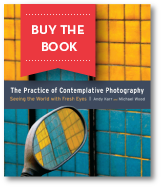Are flashes of perception always well-composed and balanced?
Hello! First of all, thank you very much for this wonderful book. I like your approach to photography very much. Especially it gives layman like me so many opportunities to shoot without having to travel to extraordinary far away places or risking their lifes while shooting catchy subject matter like wild tigers or alligators. I have some experience with Zen meditation and at first I thought I had a good grasp of flashes of perception. I know very well those moments where my mind finally comes to rest for a few seconds, the internal chatter stops and I suddenly have a much clearer, non-conceptual view of the things surrounding me. However, after looking at some of the pictures in your book, I'm a bit confused. Aren't flashes of perception mostly occuring at random? And wouldn't many of those flashes thereby include random subject matter, where form and color can occur in almost arbitrary relationships to each other? In comparison to such random perceptions, nearly all of the images included in the book seem to be very balanced and well composed. Some of the pictures, like the leaf on page 25, the plate, chair and table on page 52 or the colors reflecting in the car on page 64 also have a straight perspective below eye-level, which would require the photographer to change position (or did the according flashes truly occur in a kneeling position?) . Similarly, the sides of the house on page 101 are perfectly aligned with the frame. Though the photographer seems to have some freedom what to include in the picture during the framing stage, you explicitly state somewhere else in the book that the angle of view should not be changed during discernment. Is it allowed to change it during framing? I mean, how likely is it that flashes of perception always occur at angles and with a framing that somehow magically adhere to the rules of good composition? And if not all flashes of perception automatically adhere to such rules, how would I (non-conceptionally) decide which flashes are worth a photo and which are not? I mean, reality often can be very chaotic - how does it come that none of the pictures included in the book reflect that chaos, but all look so calm and well-organized? Another picture which puzzles me a bit is the one containing the dove on page 97. You say that one should stay with the flash of perception for some time at least, and not take the camera immediately, but obviously this is impossible with highly dynamic scenes which contain moving objects. I mean, that picture can't reflect the flash of perception you might have had seconds ago, where the dove must have been in another position. How would one approach such dynamic scenes then with the contemplative approach to photography?
These are great questions! I won't try to answer them throughly, but will offer a couple of points to consider.
Flashes of perception are not random. Gaps in the thinking process might occur at any time, but seeing emerges in those gaps where there is some alignment between eye and heart. That's the organizing principle that makes the perceptions feel well-composed. Some flashes of perception will lead to pleasing images and others will not. The images in the book have been selected from many, many images. They were not chosen randomly. They were chosen because they illustrated certain principles and because they were pleasing to us!
You correctly point out that we say that you should not try to change the angle of view during the discernment phase of the practice. The purpose of the discernment phase is to look more deeply into the perception, and any effort you make to compose an image will short-circuit this looking. It is in forming the equivalent that you might make these compositional adjustments to clarify what you have seen.
Applying these principles to dynamic scenes is possible when you are well versed in the practice. At this point it might only take seconds to experience a flash of perception, discern what you are seeing, and form the equivalent. However, there is a danger that beginners might slide over these steps and just "shoot from the hip" without really seeing.
- Login to post comments


Comments
Thanks for accepting me.
The Learner